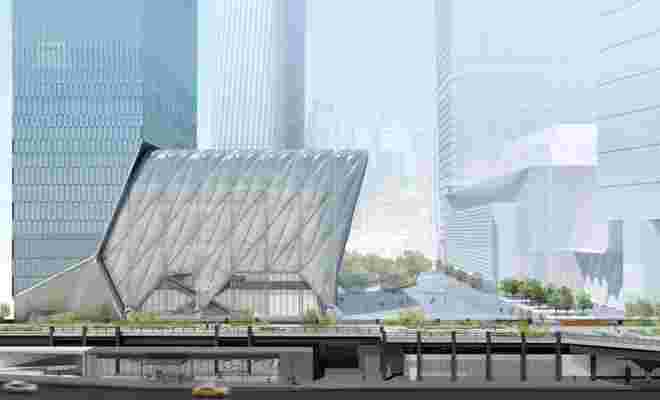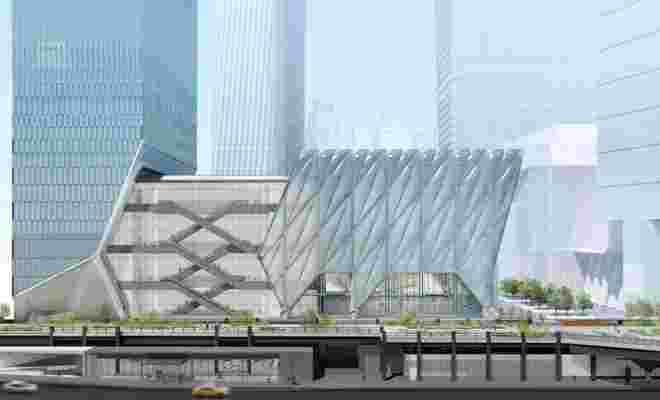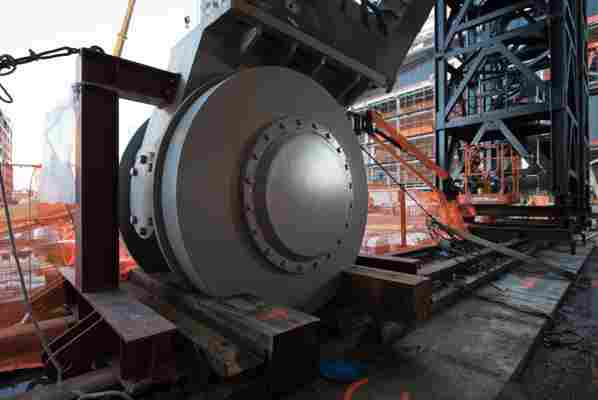Diller Scofidio + Renfro’s Moving Shed at Hudson Yards Will Amaze You
The architects of one of New York’s most anticipated new buildings, The Shed, gathered this week to—unusually—give the structure a test drive. Designed by Diller Scofidio + Renfro in collaboration with Rockwell Group , the 200,000-square-foot building has been made to glide along tracks in order to provide maximum flexibility. And just this week, for the first time, they tested out the system—and AD was there to watch. As Diller Scofidio + Renfro partner Liz Diller said, “Usually we assemble people for a ground-breaking or a ribbon cutting,” conceding how unusual it was to visit a job site to test out the movement of a building.
As for the mechanics that make its movement possible, the architects turned to a gritty precedent. “We used a gantry crane technology,” explained Diller. But unlike those shipping port gantries, with their rumbling engines and screeching wheels, The Shed moves without perceptible sound. “It’s an old-fashioned system brought up to date,” she said.

For the system to work, the structure itself had to be incredibly lightweight. By stripping it down to its bare essentials, the design team was able to make this enormous building kinetic. “Everything that’s here is here for a reason,” Diller explained in comments to AD . Pointing to its lithe skeletal frame, she said, “This building is all bone and muscle—no fat.” Rather than use glass, which would have added weight, the team will clad the space with translucent cushions of a Teflon-based material, giving the space the thermal and acoustic protection of glass but at a fraction of the weight.

The designers tucked motors into the superstructure of the upper canopy, keeping them out of sight. With the entire structure propelled from above, six colossal wheels connect to a grade-level track. “It takes the horsepower of a single Prius to move The Shed in and out,” Diller asserted.
The Shed can conjoin itself to an adjacent tower, also designed by Diller Scofidio + Renfro in collaboration with the Rockwell Group. This carried with it the advantage of being able to house much of the theatrical back-of-house systems in the tower, keeping The Shed itself unencumbered by those heavy elements.

One of The Shed's six colossal wheels.
When the designers were first commissioned to design an arts venue with surprisingly few parameters, they began, as Diller explained, by asking themselves an essential question: “What will art look like in 10 years, 20 years, 30 years?” They recognized, though, this was more theoretical than practical. “The answer,” Diller said, “we just could not know.” So, as a result, they set out to make the most flexible space possible. “The one thing we could be certain of is that art will always need space, structural support, and electrical power,” Diller said. Thus was born the concept for The Shed.
The Shed mid-construction.
Scheduled for a spring 2019 opening, The Shed will be wedged between the High Line and Thomas Heatherwick’s Vessel . The Shed will serve as a cultural anchor for Hudson Yards , a mixed-use district on Manhattan’s far west side, made possible by the extension of the subway’s 7 line.